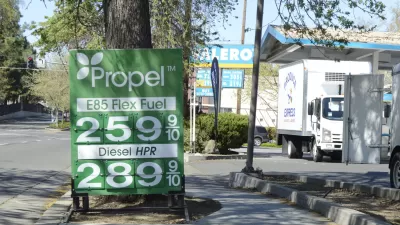Relaxed U.S. fuel economy standards, as Environmental Protection Administration chief Scott Pruitt announced on April 2, would have effects extending far beyond the United States.

Current fuel economy standards of 54.5 miles per gallon by 2025 for light-duty vehicles (passenger cars and trucks), equivalent to roughly 36-38 mpg in real-world driving, were finalized by the Obama administration in August 2012. At that time, these "standards were on pace to become some of the most aggressive in the world by 2025," report Brad Plumer and Nadja Popovich of The New York Times's climate team on April 3.
[T]hey were still less stringent than those set by the European Union, according to an analysis by the International Council on Clean Transportation [ICCT], which compared standards for different countries.
"The goal of GHG [greenhouse gas] and fuel economy standards—to limit the amount of carbon dioxide emitted by vehicles and reduce their petroleum consumption—is crucial to any realistic plan to mitigate global warming," states the introduction to the 36-page ICCT report [pdf]. The council, working with a team of West Virginia University engineers in 2015, exposed the Volkswagen diesel cheating scandal, responsible for multi-billion dollar settlements from the world's largest auto company now being used to fund clean air strategies.
The analysis examines how GHG and fuel economy standards have changed over time and how the auto industry in different regions have reacted.
Today, 10 governments—Brazil, Canada, China, the European Union, India, Japan, Mexico, Saudi Arabia, South Korea, and the United States—have established fuel economy or GHG emission standards for LDVs [light-duty vehicles].
The Obama-era 2025 greenhouse gas emissions standards, jointly set by the U.S. Environmental Protection Administration and the National Highway Transportation Safety Administration on behalf of the U.S. Department of Transportation in collaboration with the California Air Resources Board [pdf], were a huge boost in contrast to the 2016 real-world driving standards of 24.7 mpg, write Plumer and Popovich.
On April 2, U.S. Environmental Protection Agency (EPA) Administrator Scott Pruitt announced that he would be revising the aforementioned GHG emissions standards having signed the Mid-term Evaluation Final Determination. "If the Trump administration does significantly relax the fuel-economy rules, that could have ripple effects around the world," add Plumer and Popovich.
Canada, for instance, has harmonized its standards with the United States, while Mexico and Saudi Arabia essentially use the United States as a model for their own vehicle rules, albeit with a few years’ lag.
The European Union is currently considering a new round of even stricter standards that extend until 2030, while Australia has been exploring new vehicle rules modeled off the United States. “If the U.S. weakens its rules, automakers elsewhere could use that to lobby European and Australian regulators to be less strict,” said Anup Bandivadekar, a researcher at the International Council on Clean Transportation.
That "rippling effect" is restated in the European media platform, EURACTIV. "In Europe, the EPA’s [April 2] announcement could encourage policymakers to adopt a softer stance on new CO2 emission standards currently being discussed at EU level for 2030," reports Frédéric Simon on April 3.
German auto association VDA has already picked up on the new US direction in order to push back against CO2 targets for cars at European level. Environmental campaigners are worried they will use the US move to weaken the EU’s Clean Mobility package presented by the European Commission last November, which included new CO2 emission targets for 2030.
FULL STORY: How U.S. Fuel Economy Standards Compare With the Rest of the World’s

Alabama: Trump Terminates Settlements for Black Communities Harmed By Raw Sewage
Trump deemed the landmark civil rights agreement “illegal DEI and environmental justice policy.”

Study: Maui’s Plan to Convert Vacation Rentals to Long-Term Housing Could Cause Nearly $1 Billion Economic Loss
The plan would reduce visitor accommodation by 25% resulting in 1,900 jobs lost.

Planetizen Federal Action Tracker
A weekly monitor of how Trump’s orders and actions are impacting planners and planning in America.

Waymo Gets Permission to Map SF’s Market Street
If allowed to operate on the traffic-restricted street, Waymo’s autonomous taxis would have a leg up over ride-hailing competitors — and counter the city’s efforts to grow bike and pedestrian on the thoroughfare.

Parklet Symposium Highlights the Success of Shared Spaces
Parklets got a boost during the Covid-19 pandemic, when the concept was translated to outdoor dining programs that offered restaurants a lifeline during the shutdown.

Federal Homelessness Agency Places Entire Staff on Leave
The U.S. Interagency Council on Homelessness is the only federal agency dedicated to preventing and ending homelessness.
Urban Design for Planners 1: Software Tools
This six-course series explores essential urban design concepts using open source software and equips planners with the tools they need to participate fully in the urban design process.
Planning for Universal Design
Learn the tools for implementing Universal Design in planning regulations.
Caltrans
Smith Gee Studio
Institute for Housing and Urban Development Studies (IHS)
City of Grandview
Harvard GSD Executive Education
Toledo-Lucas County Plan Commissions
Salt Lake City
NYU Wagner Graduate School of Public Service





























